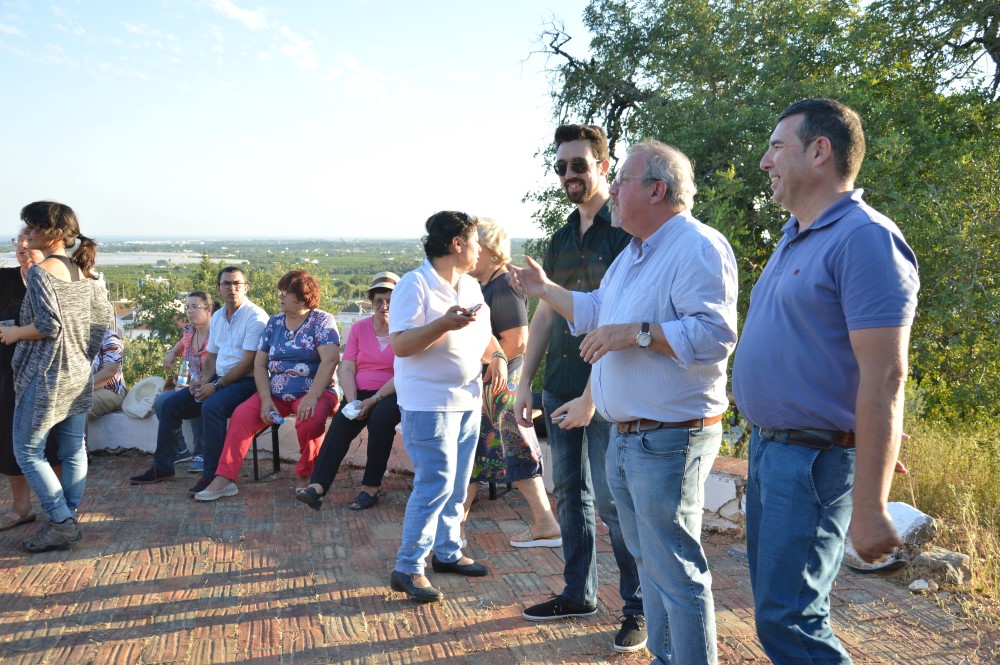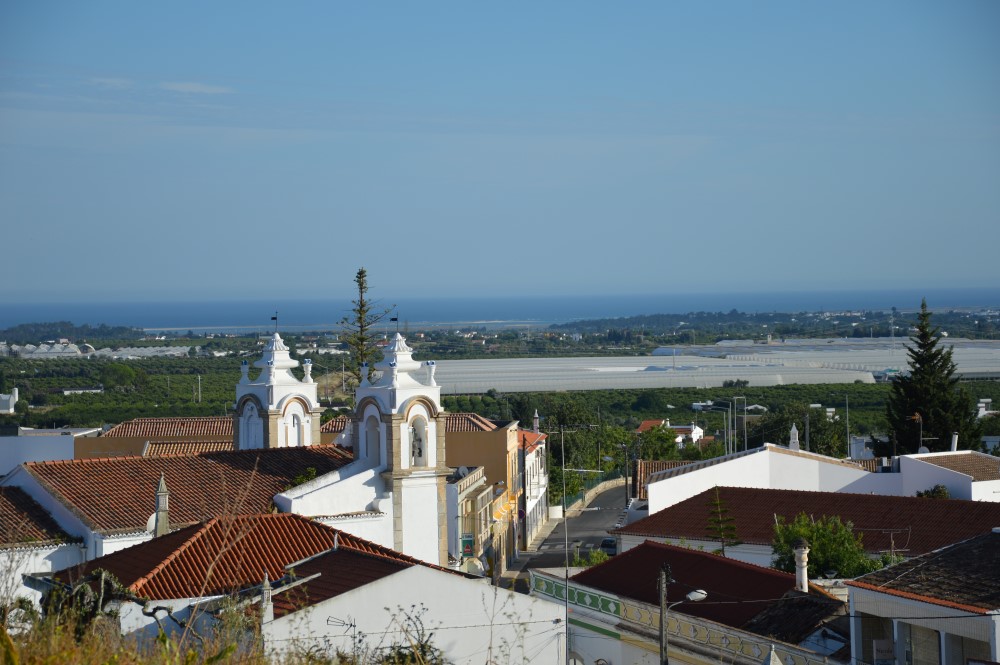 Senhor Sequeira's threshing floor is located on top of a hill, with the village of Santo Estêvão at its feet and open views over the plain of dryland orchards and orange trees in Luz de Tavira, the Ria Formosa and the sea in the background. . Recently, you can still see the plastic stain of the greenhouses of intensive agriculture, which are invading the landscape of the Eastern Algarve.
Senhor Sequeira's threshing floor is located on top of a hill, with the village of Santo Estêvão at its feet and open views over the plain of dryland orchards and orange trees in Luz de Tavira, the Ria Formosa and the sea in the background. . Recently, you can still see the plastic stain of the greenhouses of intensive agriculture, which are invading the landscape of the Eastern Algarve.
This threshing floor, which was used to thresh cereals, taking advantage of the wind from above to help in this seasonal agricultural task, is one of the places where, for three days, from 26 to 28 May, the first edition of the Barro Cal – 1st Festa do Barrocal Algarvio, a cultural and artistic project to enhance the territory, heritage and people.
Eduardo Sequeira, the so-called Sequeira who owns the space, says that, although the threshing floor, with a floor made of Santa Catarina tile, no longer serves its primary function, he always tries to “keep it in good condition”. Today it is above all “because of the view”. «It seems that we are at the altar of the Algarve», he comments, in conversation with the Sul Informação, during the snack that, last week, served to present this first edition of Barro Cal, which starts tomorrow.
The farm in Vale da Palmeira, where the threshing floor is located, now has 40 hectares and is owned by Eduardo Sequeira. But it already had at least twice as much, when it belonged to the great-grandfather of D. Maria do Rosário Valagão, who was also there at the presentation, sitting on the whitewashed wall.
Before, the farm produced olives for oil, dried fruits (carobs and almonds, above all), and there were about six lime kilns, using the limestone of the land. Today, according to Eduardo Sequeira, it mainly produces carob, table olives and oranges. And there are still two lime kilns, but they no longer produce anything. Still, one of the activities of the 1st Festa do Barrocal Algarvio it will be a walking tour in search of memories of these lime kilns.
Jorge Queiroz, director of the Museum of Tavira and director of AGECAL (Association of Cultural Managers of the Algarve), which promotes the initiative and is even based in Santo Estêvão, explains that the snack – made with cakes, snacks, fruits, wines and even craft beer offered by the villagers – it was “a meeting with local people, before the fair itself”. Next door, setting the tone for the party, the accordionist and some of the ladies singing rehearsed the march of Santo Estêvão.
“This is a process of applied cultural management, to demonstrate how cultural resources can contribute to local development”, adds Jorge Queiroz, who is keen to stress that “this is a process in reverse: what matters is the people of Santo Estêvão, his knowledge, his initiatives, AGECAL is in the background, it only serves to embody the organization. We are just enablers for what people are going to do».
The program (which can be found in detail below) includes things like singing in the countryside (with the Moçoilas) or dancing in the countryside (with Filipa Rodriguez), making and flying kites, as well as tours to discover medicinal plants, traditional architecture and the platbands, plants and fruits used in the manufacture of liqueurs, from the parish church of Santo Estêvão.
There will also be a shared picnic lunch (on Sunday), a seminar on «The countryside as a natural resource», as well as, at 18:00 tomorrow, the opening of the exhibitions on Barrocal, authored by AGECAL, by photographer Filipe da Palma ( heritage) by José Filipe (fauna and flora) and the accordion collection by Vítor Faleiro (at 18 pm).
And, although the organization emphasizes that this is not the most important part of this village festival, there will be music with resonant names, but in keeping with the spirit: Né Ladeiras (Friday, May 26, at 21 pm) and Júlio Pereira (Saturday at the same time). As it could only be a true village festival, everything will end with a ball, from 30 pm on Sunday, with traditional music from Mito Algarvio.
Of course, in addition to the activities, there will be much more to see, buy, eat and drink, in stalls set up along the streets of the village of Santo Estêvão. Who will be there will be Sebastião Afonso, from Algarve Moura craft beer, who is even from Santo Estêvão, or D. Natália Pereira, who is also from the village and will sell her almond and carob cakes and more. O Sul Informação tasted them in the snack and guarantees that they are delicious. but there will be much more to taste and buy.
AGECAL, explained Emanuel Sancho, director of the Costume Museum of São Brás de Alportel and also leader of the association, is made up of volunteers. «With this Barro Cal party, we want to repay the welcome that we were given in the village».
Emanuel Sancho is the main responsible for an exhibition – which will later be itinerant – and which intends to “unveil this question of what Barrocal is. If we go to the old dictionaries, it is a thicket of stones, where very poor agriculture is carried out. But it is much more than that!».
The exhibition, which will premiere tomorrow, Friday, at the opening seminar of the festival, will present «the scientific aspects, literature, of foreign travelers who have visited and written about the Algarve's Barrocal. We will also have testimonies and experiences, on video, with the collaboration of people who are here from the village of Santo Estêvão, such as D. Tolentina or D. Maria do Rosário. But we will also look to the future: what are the threats? desertification? the plastification brought about by intensive agriculture?».
Emanuel Sancho leaves a message of hope, speaking of the “younger generations that are fighting against the tide, namely betting on local products”. And it will also be a little bit of this that, from tomorrow until Sunday, will be able to be known, tasted, tasted and even bought in Santo Estêvão.
As the organization of the initiative says, «the “Barro Cal” assumes a playful and educational function, of relearning knowledge, of a balanced relationship between man and nature, of sensitizing current and future generations to the multiple sources of knowledge and artistic disciplines».
It is, therefore, "a party that encourages a taste for the countryside, a re-encounter with ancestral values, dance, music, orality, games, socializing and sharing". On a weekend where there are countless proposals from one end of the Algarve to the other, let yourself be enchanted by the genuineness of Santo Estêvão, this village in the interior of the municipality of Tavira, with about two dozen inhabitants and where the good can still breathe. ares of the Algarve Barrocal.
The 1st Festa do Barrocal Algarvio is organized by AGECAL, which has the support of the Municipality of Tavira, the Parish of Luz de Tavira and Santo Estêvão, as well as the 365 Algarve Programme. The Casa do Povo of Santo Estêvão also collaborates with this initiative.
Click here to see the full Barro Cal program
Photos: Elisabete Rodrigues|Sul Informação






























Comments